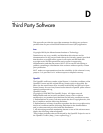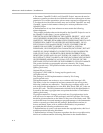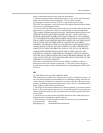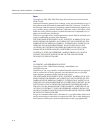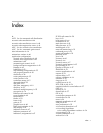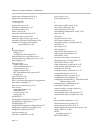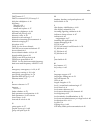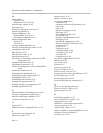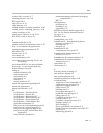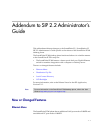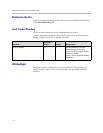
Administrator’s Guide SoundPoint IP / SoundStation IP
Index – 2
application configuration file A–4
application error messages 5–3
application files
overview 2–6
Applications key 4–28
attendant <attendant> A–97
attended transfers 4–17
audio codecs 4–45
automatic call distribution 4–33
automatic gain control 4–46
automatic gain control <agc> A–43
automatic off-hook call placement 4–16
automatic off-hook call placement
<autoOffHook> A–88
B
background logo
adding C–5
configuration file changes C–6
background noise suppression 4–46
background noise suppression <ns> A–42
basic logging A–71
basic protocols
header support B–4
hold implementation B–9
request support B–3
response support B–6
RFC and Internet draft support B–2
transfer B–9
basic TCP/IP A–50
blind transfers 4–17
BNS. See also background noise suppression
boot failure messages 5–7
boot server security policy 3–14
boot servers
deploying phones 3–15
redundant 3–12
security policy 3–14
setting up
3–13
bootROM 2–3
bootROM and application wrapper 2–5
bootROM error messages 5–2
bootROM tasks 2–3
bootROM/SIP application dependencies C–7
bridged line appearance signaling B–10
bridged line appearances 4–24
browser limits A–81
bulk drive <bulkDrive> A–82
busy <busy> A–91
busy lamp field 4–25
C
call control <callControl> A–48
call control, third party B–9
call forwarding 4–18, A–90
call handling configuration <call> A–55
call hold 4–16
call log 4–3
call park/retrieve 4–20
call progress patterns A–30
call progress tones, synthesized 4–28
call timer 4–3
call transfer 4–17
call waiting 4–3
called party identification 4–4
calling party identification 4–4
calls <calls> A–88
central provisioning, overview 2–6
changing the key on the phone C–5
chord-sets <chord> A–26
codec preferences <codecPref> A–35
codec profiles <audioProfile> A–36
comfort noise fill
4–46
conference setup <conference> A–15
configurable feature keys 4–21
configuration file encryption 4–49
configuration file example 4–39
configuring SoundPoint IP / SoundStation IP
phones locally 4–50
connected party identification 4–5
consultative transfers 4–17
context sensitive volume control 4–5
custom certificates 4–48
customizable audio sound effects 4–5
customizable fonts and indicators 4–26
D
date and time <datetime> A–23
default feature key layouts C–10
default password 3–5, 4–50, C–9
deploying phones from the boot server 3–14
device <device> A–100
DHCP
secondary server 3–3
DHCP INFORM 3–3





